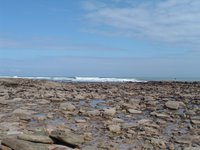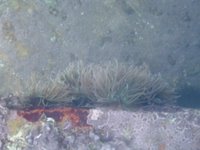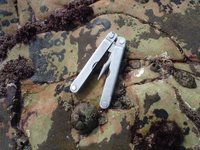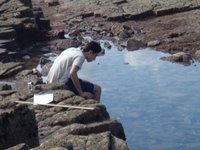Sugar and Snails and Everything Nice
 There's a tradition here, that you bring a pillar of sugar, a qalib, if someone experiences a death in the family. We recently had a basketball game between staff and students, the first game of the school I've attended. (I'm more interested in football as it's more contextual in this county.) Last year the students won; this year it was the staff, by about 12 points. So I brought in the qalib and place it on the overhead. When students asked about it, as I knew they would, I responded, "I have heard it is tradition here that you bring a qalib when someone experiences a loss. I have brought this then for the students, who have experienced such a huge loss yesterday." See, it was a good game, but there was way not enough trash talk on the court. And now I've got enough sugar at home to make 4, maybe 5, cups of tea.
There's a tradition here, that you bring a pillar of sugar, a qalib, if someone experiences a death in the family. We recently had a basketball game between staff and students, the first game of the school I've attended. (I'm more interested in football as it's more contextual in this county.) Last year the students won; this year it was the staff, by about 12 points. So I brought in the qalib and place it on the overhead. When students asked about it, as I knew they would, I responded, "I have heard it is tradition here that you bring a qalib when someone experiences a loss. I have brought this then for the students, who have experienced such a huge loss yesterday." See, it was a good game, but there was way not enough trash talk on the court. And now I've got enough sugar at home to make 4, maybe 5, cups of tea. So today was another field trip with the Marine Biology class. My roommate who heads up a surfing company (Kai Boardriding Company- teaching and making boards) often goes there. I'm shocked at myself for never seeing this place at low tide before,in 2 1/2 years! It was absolutely wonderful. I've been there before when it was high tide, but never seen really the diversity possible in this area when it's low tide, in the right spot. Giant limpets;
So today was another field trip with the Marine Biology class. My roommate who heads up a surfing company (Kai Boardriding Company- teaching and making boards) often goes there. I'm shocked at myself for never seeing this place at low tide before,in 2 1/2 years! It was absolutely wonderful. I've been there before when it was high tide, but never seen really the diversity possible in this area when it's low tide, in the right spot. Giant limpets; snails galore; green-striped crabs and fluffy yellow crabs; Cthamalus barnacles, giant Balanus barnacles, and goose-necked barnacles (rather gigantic size- bigger than I've ever seen); octopi larger than a man's fist; algae; rock-boring sea urchins; 3 species of seastar; 4 species of anemone (including striped and polka-dotted varieties)...It was absolutely beautiful. Yes, it was the same student, The Count, who was able to find again all the varieties of anemones. One Moroccan guy walking by helped us
snails galore; green-striped crabs and fluffy yellow crabs; Cthamalus barnacles, giant Balanus barnacles, and goose-necked barnacles (rather gigantic size- bigger than I've ever seen); octopi larger than a man's fist; algae; rock-boring sea urchins; 3 species of seastar; 4 species of anemone (including striped and polka-dotted varieties)...It was absolutely beautiful. Yes, it was the same student, The Count, who was able to find again all the varieties of anemones. One Moroccan guy walking by helped us  out in our request by capturing a large octopus alive- but he severely damaged it in the process, exposing it's brain. Unlike the other inverts without brains, Octopi can't survive well without a working brain, and sadly he died in about an hour. We found another octopus inside a small cave, but none of us were wanting
out in our request by capturing a large octopus alive- but he severely damaged it in the process, exposing it's brain. Unlike the other inverts without brains, Octopi can't survive well without a working brain, and sadly he died in about an hour. We found another octopus inside a small cave, but none of us were wanting  to risk losing part of a finger by putting our hand inside to pull it out, and when objects like pens were stuck inside, his 2000 suckers with 0.17 lbs. (1.67 N) of pressure per sucker were nearly powerful enough to pull the pen out of our hands. He didn't go for the dead octopus we stuck outside to lure him out, though he was happy enough to nibble on it if we put the dead octopus on the edge of the cave.
to risk losing part of a finger by putting our hand inside to pull it out, and when objects like pens were stuck inside, his 2000 suckers with 0.17 lbs. (1.67 N) of pressure per sucker were nearly powerful enough to pull the pen out of our hands. He didn't go for the dead octopus we stuck outside to lure him out, though he was happy enough to nibble on it if we put the dead octopus on the edge of the cave. We spent the day in a few different transects. The 1st was horizontal, with each student having a 12x1 meter swatch to observe all species and their diversity meter by meter. The 2nd was vertical, with a sloping or near cliff face to identify the 12 most dominant species and their total numbers in each 1/4 meter. Throughout this time, they had to analyze the water quality for salinity, dissolved oxygen content, pH, phosphates, and nitrates. (The salinity tester has some rather noxious chemicals in it. I'm
We spent the day in a few different transects. The 1st was horizontal, with each student having a 12x1 meter swatch to observe all species and their diversity meter by meter. The 2nd was vertical, with a sloping or near cliff face to identify the 12 most dominant species and their total numbers in each 1/4 meter. Throughout this time, they had to analyze the water quality for salinity, dissolved oxygen content, pH, phosphates, and nitrates. (The salinity tester has some rather noxious chemicals in it. I'm hoping these brown stains on my hands will go away...) They also drew pictures and identified as best as possible the species we were observing, using an extensive N. American field guide and a more limited Mediterranean Field Guide. It was an excellent field trip, and we all had a lot of fun,
hoping these brown stains on my hands will go away...) They also drew pictures and identified as best as possible the species we were observing, using an extensive N. American field guide and a more limited Mediterranean Field Guide. It was an excellent field trip, and we all had a lot of fun,  despite it being cloudy and cold in the morning enough that I didn't think I'd need a hat and sunblock, for which reason I was sorely disappointed to discover myself red enough to appear to be supporting the red football team in Casa, Widad.
despite it being cloudy and cold in the morning enough that I didn't think I'd need a hat and sunblock, for which reason I was sorely disappointed to discover myself red enough to appear to be supporting the red football team in Casa, Widad.At the end of the day, we had collectected a large number of specimens, including the egg case of
 a "paper nautilus" (a form of octopus) and a test (shell of a sea urchin). We took a number of them back to school and set up a tank for all the species listed above. That gave us the opportunity to observe them closely in vivo. Some of the organisms were able to latch on to the new plastic surfaces. The limpet the size of the palm of the hand latched on with great force to the glass cover of one of the jars, and had to be pried off again. The urchins put out their tube feet podia and were waving them around. The crabs, annelids (green worms with legs), brittle star, and seastars started walking around even before the oxygenizer was inserted. But I'm worried about the mussels and barnacles and goose-necked barnacles, who aren't used to being transplanted after settling down for life in recruitment. Especially the goose-necked barnacle had to be pried off with some mess, and we got to observe one of the hermit crabs going to dinner on the base of it.
a "paper nautilus" (a form of octopus) and a test (shell of a sea urchin). We took a number of them back to school and set up a tank for all the species listed above. That gave us the opportunity to observe them closely in vivo. Some of the organisms were able to latch on to the new plastic surfaces. The limpet the size of the palm of the hand latched on with great force to the glass cover of one of the jars, and had to be pried off again. The urchins put out their tube feet podia and were waving them around. The crabs, annelids (green worms with legs), brittle star, and seastars started walking around even before the oxygenizer was inserted. But I'm worried about the mussels and barnacles and goose-necked barnacles, who aren't used to being transplanted after settling down for life in recruitment. Especially the goose-necked barnacle had to be pried off with some mess, and we got to observe one of the hermit crabs going to dinner on the base of it.On Monday, insha'allah, we'll begin some labs, using live specimens, if they are still alive. I hope to observe the sea urchins alive and then dissect them, and see the flow of water over the mussel gills. And a particularly fun experiment- gently crack open the hermit crab shells, releasing the hermit crabs, and providing them with another shell, and watching what happens. Typically, they set up a heirarchy of shells, so if you drop a particularly nice one in the tank (be it a snail shell or a thimble), the top crab will drop his shell and grab the new one, the 2nd crab will do the same, grabbing the previous shell of the top crab, and so on.
I've blogged before how good the snails are here- especially in the juice. You can buy them from a number of stands in my neighborhood. But there are also women lined up for a fair stretch on the road to my school. Each has her own cart with a separate number. When the police come, they don't seem to have permits to be there, as they all run away. Ocassionally you see a car stop and buy some snails from them. But evidently, its quite popular. The other night, coming back from a Bible Study at the school, we ran into a huge amount of traffic. We creeped forward, and fully expected to see a large accident blocking the road. No. Just car after car, double-parked 3 abreast, lined up to buy snails.
Comments
Kif halak.
Peace
Sam
You are hilarious! The pillar of sugar looks -enormous!- Thanks for the reminder on diversity transects. I might suggest to my students that they try that when they go on there natural ecursions for my class. I'll probalby try it with the ones I take out.
I'm hanging with my brother today, grading papers while he cooks, hops around on that leg of his...
Quaintance